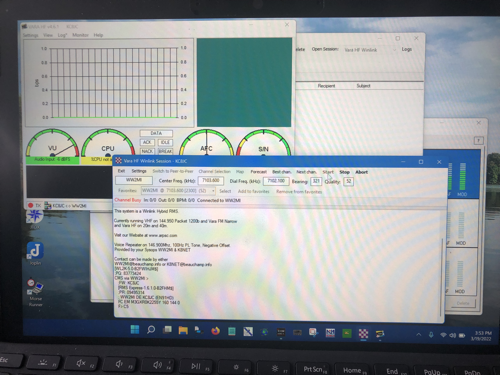This weekend wasn’t a great one for portable operations in NE Ohio. The weather was cold and rainy. As someone who spends a lot of time outside, I get that there is No Bad Weather, Only Bad Gear. That said, I’m not out to prove anything and if it doesn’t look fun, I’m not gonna do it. So as I stared at the forecast, I decided to take a different approach.
I’ve been looking at the Chameleon Hybrid Micro with wire antenna for a while. My thinking was that I already have the whip that I use in conjunction with the MP1 from time to time and that it might make for a better long term deployment than my EndFedz backpack-friendly antenna. The wire is far more rugged and the Micro might give me a little more flexibility in the field with both wire and whip handy. It’s times like these, when silly ideas fly into my funnel, that it’s nice to be within 20-ish minutes of DX Engineering with nifty curbside pickup.
One of the experiments that was still pending in my notebook was sending a Winlink message from my portable setup. With the new antenna and several untested options in hand, I figured I could spend an hour or two and at least take some measurements. If things went really well, perhaps even run a practical experiment or two.
Instead of heading to the park I went to the side yard of my house. There are many options there given that the trees in the front yard are easy enough to put a wire in and there is a covered front porch where my radio and computer (and I) can stay nice and dry. I started by deploying the micro in the ground with the Chameleon spike and attaching the whip. I got some good readings. I noodled around a bit and tried to connect to a Winlink server. No dice. I will freely admit that I didn’t really do a lot of control here as a part of this experiment and that I didn’t spend any time troubleshooting the whip. Instead, while the rain was giving me a break, I got the wire in a tree in a rather long sloper configuration. That was a whole different story right out of the gate.
With the wire antenna, I got to a server on the first try and sent my test message. Same power. Same tuner. Same rig. But a very different antenna setup. In both setups, the SWR is pretty good and the tuner doesn’t have to work too hard to get an almost 1:1 match. But the devil is in the efficiency and radiation details, right? I’ll leave that math to AC8NT. What I know is what I see in practice and The Wire Is The Way (for that application in that moment).

This is a good time to stop and once again state for the record that my initial criticism of the mAT-705 (Original Version) was harsh. This little unit tunes right up and is the perfect size for what I want it to be. I’m sorry, little buddy. You’re welcome in my bag any day. I still hate changing your battery (which I haven’t had to do since the day you arrived with a dead batter which is hard to forgive).
The advantage of the Chameleon setup that didn’t come to me until later was the ability to use it with the Hardrock-50. The EndFedz antenna has a maximum rating of 25 watts. The Chameleon is good to 100 watts which I won’t ever hit with my portable setup. So again, I have more options. And options are critical for field work. I mostly see myself using the Hardrock-50 when I’m stationary for a longer period. The best examples being car camping or cabin camping. It’s highly unlikely that I’d backpack with it, but I can easily see myself using it from the Jeep or in an emergency scenario.
While I didn’t get any POTA activation time in, I still felt pretty good about the progress made. I checked off an outstanding experiment and even got a chance to acquire and play with a new toy.
![]()